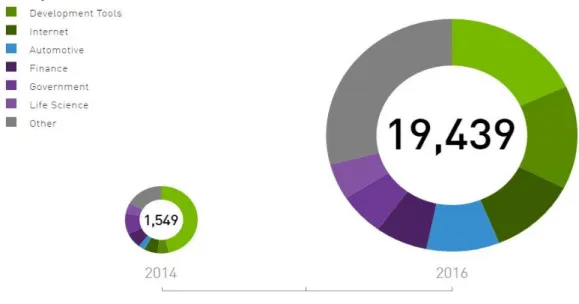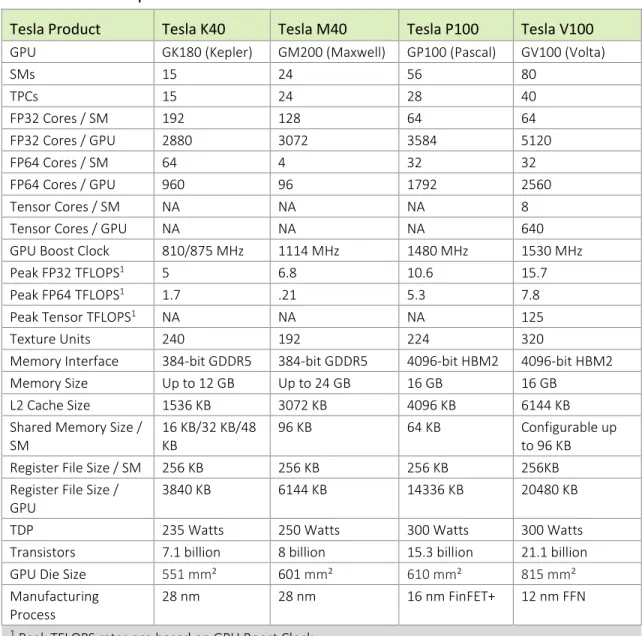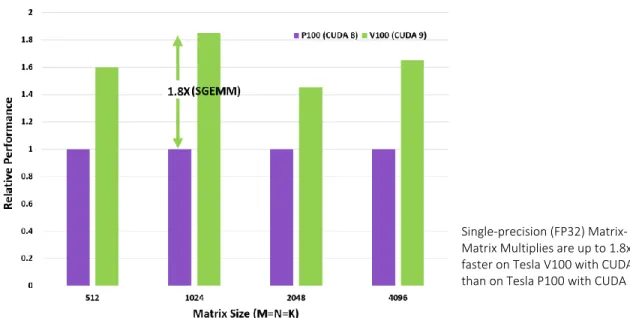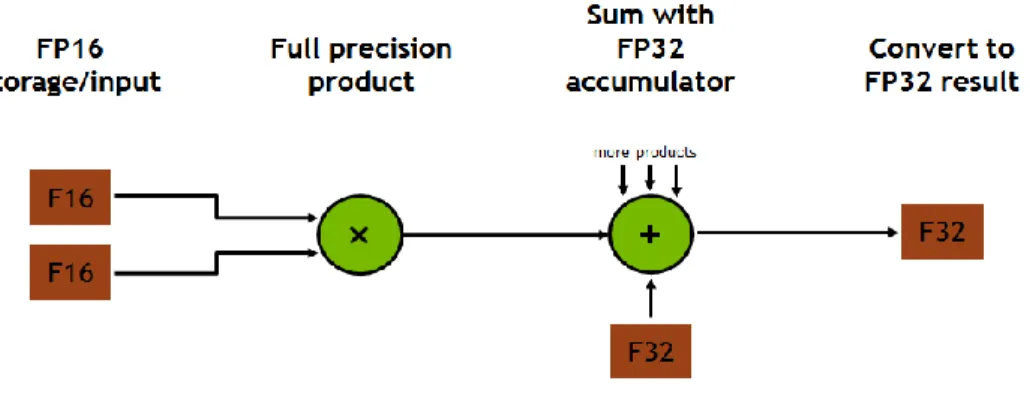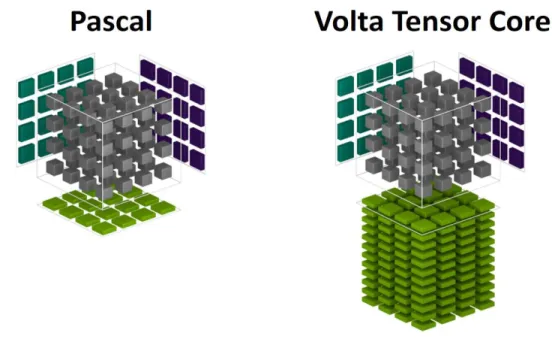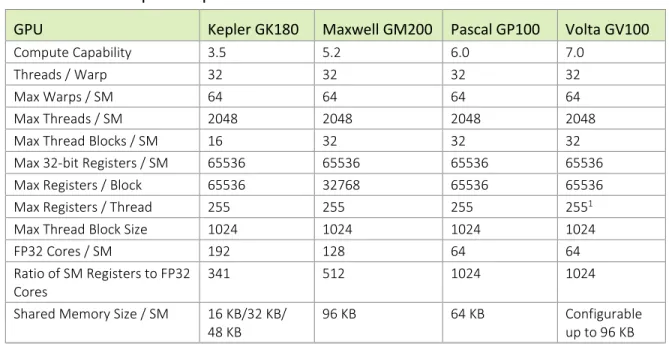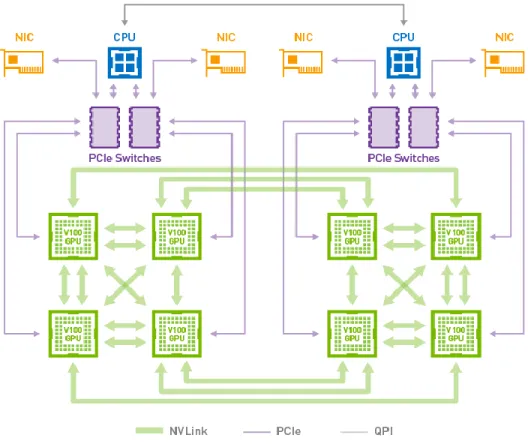The new NVIDIA® Tesla® V100 accelerator (shown in Figure 1) incorporates the powerful new Volta™ GV100 GPU. The NVIDIA Tesla V100 accelerator is the world's highest performing parallel processor, designed to power the most compute-intensive HPC, AI and graphics workloads.
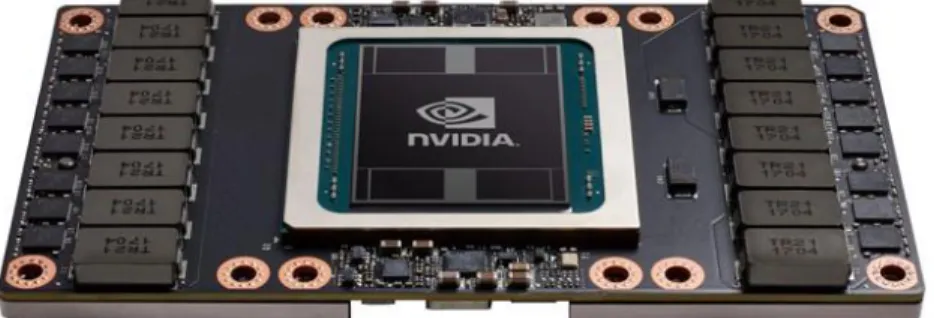
NVIDIA GPUS THE FASTEST AND MOST FLEXIBLE DEEP LEARNING PLATFORM
DEEP LEARNING BACKGROUND
GPU-ACCELERATED DEEP LEARNING
GV100 GPU HARDWARE ARCHITECTURE IN-DEPTH
EXTREME PERFORMANCE AND HIGH EFFICIENCY
VOLTA STREAMING MULTIPROCESSOR
New Tensor Cores are a key capability enabling the Volta GV100 GPU architecture to deliver the performance needed to train large neural networks. The Tesla V100 GPU contains 640 Tensor Cores: eight (8) per SM and two (2) per processing block (partition) within an SM. Tensor Cores provide up to 12x higher peak TFLOPS on Tesla V100 that can be applied to deep learning training compared to using standard FP32 operations on P100.
Volta tensor kernels are accessible and exposed as Warp-level matrix operations in the CUDA 9 C++ API. The API exposes specialized matrix loading, matrix multiplication and accumulation, and matrix matrix to efficiently use Tensor Kernels from a CUDA-C++ program. NVIDIA has worked with many popular deep learning frameworks such as Caffe2 and MXNet to enable the use of Tensor Cores for deep learning research.
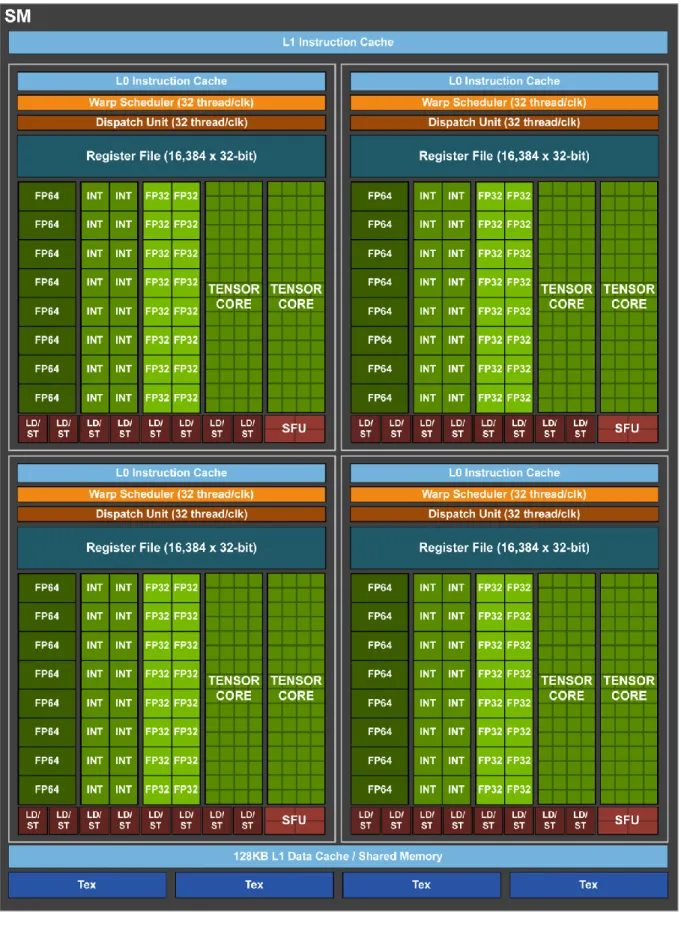
COMPUTE CAPABILITY
The GV100 L1 cache improves performance in a variety of situations where shared memory is not the best choice or cannot work. With Volta GV100, the fusion of shared memory and L1 delivers a high-speed path to global memory that can access stream with unlimited in-flight cache. Unlike Pascal GPUs, which could not execute FP32 and INT32 instructions simultaneously, the Volta GV100 SM contains separate FP32 and INT32 cores, enabling simultaneous execution of FP32 and INT32 operations at full throughput, while also instruction issue throughput increased.
Latency to issue dependent instructions is also reduced for basic FMA (Fused Multiply-Add) math operations, requiring only four clock cycles on the Volta compared to six cycles on the Pascal. Many applications have internal loops that perform pointer arithmetic (integer memory address calculations) combined with floating-point calculations that will benefit from simultaneous execution of FP32 and INT32 instructions.
NVLINK: HIGHER BANDWIDTH, MORE LINKS, MORE FEATURES
HBM2 MEMORY ARCHITECTURE
The Tesla V100 HBM2 memory subsystem supports Error Correcting Code (ECC) with single error correction (SECDED) to protect data. HBM2 supports native or sideband ECC, where a small area of memory, separate from main memory, is used for ECC bits. This compares to inline ECC where a portion of main memory is carved out for ECC bits, as in the GDDR5 memory subsystem of the Tesla K40 GPU where 6.25%.
For memory writes, the ECC bits are calculated across 32 bytes of data in a write request. For memory reads, the 32 ECC bits are read in parallel with each 32-byte read of data. Other key structures in the GV100 are also protected by SECDED ECC, including the SM register file, L1 cache, and L2 cache.
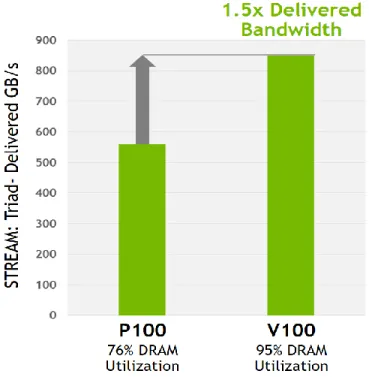
COPY ENGINE ENHANCEMENTS
TESLA V100 BOARD DESIGN
GV100 CUDA HARDWARE AND SOFTWARE ARCHITECTURAL ADVANCES
INDEPENDENT THREAD SCHEDULING
Volta's independent thread scheduling allows the GPU to run any thread, either making better use of execution resources or making one thread wait for data produced by another. It is interesting to note that Figure 22 does not show the execution of instruction Z by all threads in the warp at the same time. This allows the execution of fine-grained parallel algorithms where threads within a warp can synchronize and communicate.
Consider a simplified example enabled by Volta's independent thread scheduling: inserting nodes into a doubly linked list in a multithreaded application. The independent thread scheduling in Volta ensures that even if thread T0 currently holds the lock for node A, another thread T1 in the same base can successfully wait for the lock to become available without impeding thread T0's progress. This doubly linked list with precision locks is a simple example, but it shows how independent thread scheduling allows developers to naturally implement familiar algorithms and data structures in GPUs.

VOLTA MULTI-PROCESS SERVICE
It is also important to note that the use of one lock per node in the above example is critical for performance on the GPU. Quality of Service is how quickly GPU execution resources will be available to process work for a client after the job is submitted. Volta MPS provides control for MPS clients to specify which part of the GPU is needed for execution.
This control of limiting each client to only a fraction of the GPU rendering resources reduces or eliminates head-of-line blocking where work from one MPS client can overwhelm GPU rendering resources, preventing other clients from making progress until previous work from another MPS client has been completed. Volta offers very high throughput and low latency for deep learning inference, especially when there is a batch system in place to collect images to submit to the GPU simultaneously to maximize performance. Volta MPS provides an easy option to improve throughput while meeting latency targets by allowing many individual inference tasks to be submitted to the GPU simultaneously and improving overall GPU utilization.
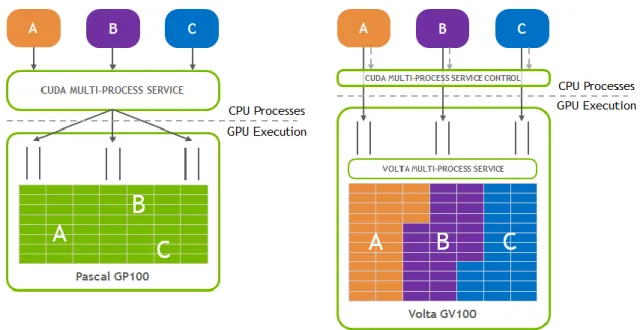
UNIFIED MEMORY AND ADDRESS TRANSLATION SERVICES
An important feature for Volta MPS includes support for the Unified Memory feature roadmap with Linux support (for example, malloc memory access from the GPU). ATS gives the GPU full access to CPU memory, for example to memory allocated directly with 'malloc'.
COOPERATIVE GROUPS
Cooperative Groups uses C++ templates to provide types and overload APIs to represent groups whose size is statically determined for even greater efficiency. Collaborative groups allow programmers to express synchronization patterns that they could not express before. Libraries of collective primitives written using cooperative groups often require less complex code to achieve high performance.
Cooperative Groups provides flexible and scalable thread group types and synchronization primitives enable parallelism reallocation in situations such as the example above within a single kernel launch. Using this_grid() defines a thread group that includes all threads from the kernel launch, which is then synchronized between the two phases. The Cooperative Groups this_multi_grid() function returns a thread group that includes all threads from a kernel launch across multiple GPUs.
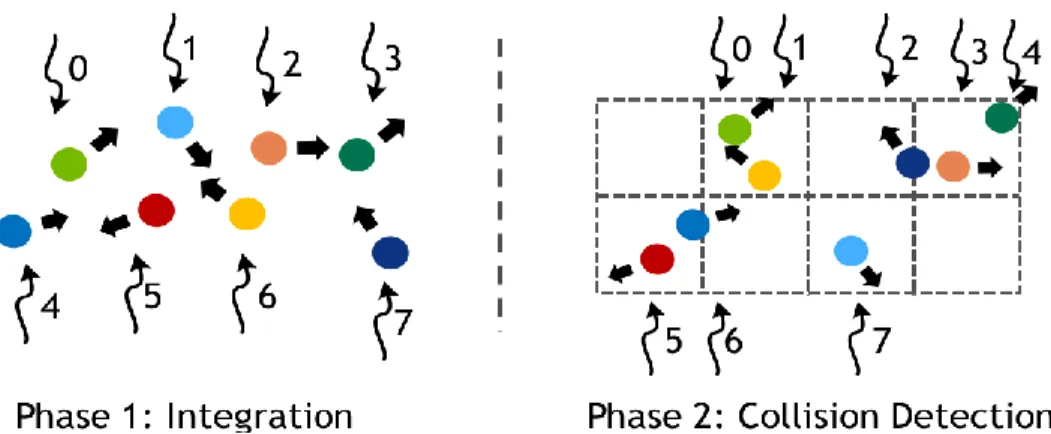
CONCLUSION
Note that in both cases the thread_rank() method provides the linear index of the current thread within the thread pool, which the kernel uses to iterate particles in parallel in case there are more particles than threads. To use groups that span multiple thread blocks or multiple GPUs, applications must use the cudaLaunchCooperativeKernel() and cudaLaunchCooperativeKernelMultiDevice() APIs, respectively. Synchronization requires that all thread blocks are resident at the same time, so the application must also ensure that the resource usage (registers and shared memory) of the running blocks of the thread does not exceed the total resources of the GPEs.
APPENDIX A
NVIDIA DGX-1 WITH TESLA V100
NVIDIA DGX-1 SYSTEM SPECIFICATIONS
DGX-1 SOFTWARE
Combining powerful hardware with software tailored for deep learning, the NVIDIA DGX-1 provides developers and researchers with a turnkey solution for high-performance GPU-accelerated deep learning application development, testing, and network training.
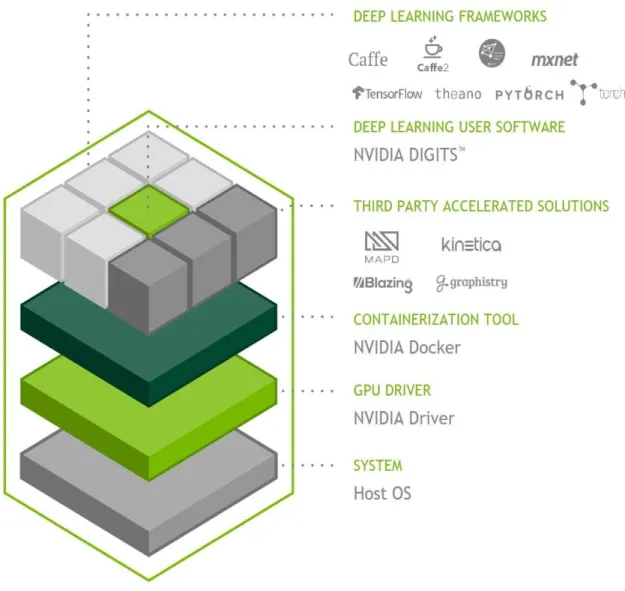
APPENDIX B
NVIDIA DGX STATION - A PERSONAL AI SUPERCOMPUTER FOR DEEP LEARNING
PRELOADED WITH THE LATEST DEEP LEARNING SOFTWARE
KICKSTARTING AI INITIATIVES
APPENDIX C
ACCELERATING DEEP LEARNING AND ARTIFICIAL INTELLIGENCE WITH GPUS
DEEP LEARNING IN A NUTSHELL
For example, consider a perceptron being trained to recognize the handwritten number zero. Obviously, the number zero can be written in different ways according to different handwriting styles. The upper right curve in the number zero can be assigned x1, the lower lower curve x2, and so on.
The green blob in the middle of the diagram is where the Perceptron calculates the weighted sum of all the features in the image to determine if the number is a zero. The perceptron model (shown in Figure 33) for detecting handwritten zeros is trained by first assigning a set of weights to each of the features that define the number zero. The perceptron is then fed the number zero to check if it correctly identifies the number.
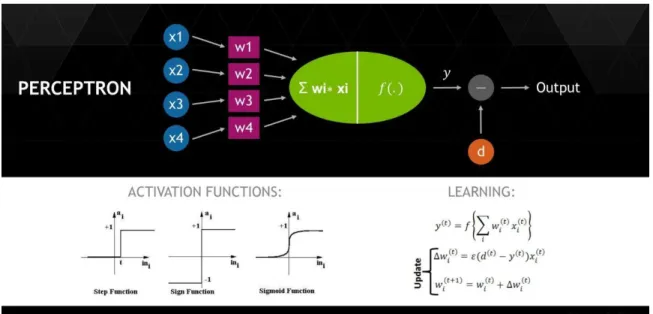
NVIDIA GPUS: THE ENGINE OF DEEP LEARNING
Neural networks rely heavily on matrix math operations, and complex multi-layer networks require enormous amounts of floating-point performance and bandwidth for both efficiency and speed. Advanced neural networks have from millions to well over a billion parameters that need to be adjusted via back-propagation. Furthermore, neural networks require a large amount of training data to converge to a high level of accuracy, meaning that hundreds of thousands to millions of input samples must be run through both a forward and backward pass (see Figure 35).
Training complex neural networks requires massive amounts of parallel computing performance, which at a basic level involves trillions of floating-point multiplications and additions. In the early days of training neural networks on GPUs, these calculations were done using single-precision floating-point (FP32) calculations in parallel, on the thousands of cores available on NVIDIA's Fermi and Kepler GPU architectures. Further research and development in the field of deep learning showed that in many cases, neural networks can be trained using semi-precise FP16 data types to achieve the same level of accuracy as training with FP32 data.

COMPREHENSIVE DEEP LEARNING SOFTWARE DEVELOPMENT KIT
And with Facebook, Google and Microsoft opening up their deep learning platforms for everyone to use, AI-powered. NVIDIA is building end-to-end deep learning platform solutions for self-driving cars with NVIDIA DRIVE PX 2, NVIDIA DriveWorks and NVIDIA DriveNet (see Figure 39)—from the training system to the AI computer in the car. This deep learning technology was developed by Preferred Networks, which was recently featured in a The Wall Street Journal article headlined "Japan Seeks Tech Revival with Artificial Intelligence".
Built on an enhanced version of Epic Games Unreal Engine 4, Isaac uses NVIDIA's advanced simulation, rendering and deep learning technologies. Deep Genomics uses GPU-based deep learning to understand how genetic variation can lead to disease. Enlitic uses deep learning to analyze medical images to identify tumors, nearly invisible fractures, and other medical conditions.
